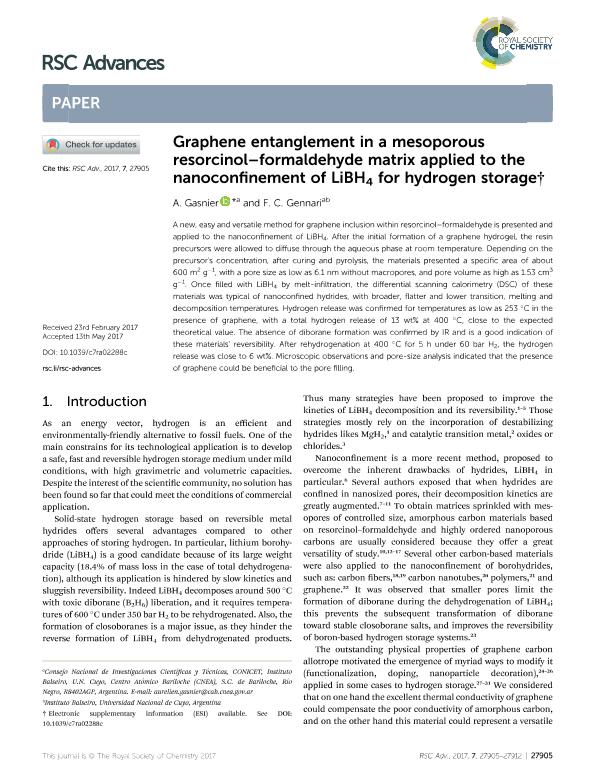Mostrar el registro sencillo del ítem
dc.contributor.author
Gasnier, Aurelien

dc.contributor.author
Gennari, Fabiana Cristina

dc.date.available
2018-08-31T17:09:13Z
dc.date.issued
2017-05
dc.identifier.citation
Gasnier, Aurelien; Gennari, Fabiana Cristina; Graphene entanglement in a mesoporous resorcinol-formaldehyde matrix applied to the nanoconfinement of LiBH4 for hydrogen storage; Royal Society of Chemistry; RSC Advances; 7; 45; 5-2017; 27905-27912
dc.identifier.issn
2046-2069
dc.identifier.uri
http://hdl.handle.net/11336/57888
dc.description.abstract
A new, easy and versatile method for graphene inclusion within resorcinol-formaldehyde is presented and applied to the nanoconfinement of LiBH4. After the initial formation of a graphene hydrogel, the resin precursors were allowed to diffuse through the aqueous phase at room temperature. Depending on the precursor's concentration, after curing and pyrolysis, the materials presented a specific area of about 600 m2 g-1, with a pore size as low as 6.1 nm without macropores, and pore volume as high as 1.53 cm3 g-1. Once filled with LiBH4 by melt-infiltration, the differential scanning calorimetry (DSC) of these materials was typical of nanoconfined hydrides, with broader, flatter and lower transition, melting and decomposition temperatures. Hydrogen release was confirmed for temperatures as low as 253 °C in the presence of graphene, with a total hydrogen release of 13 wt% at 400 °C, close to the expected theoretical value. The absence of diborane formation was confirmed by IR and is a good indication of these materials' reversibility. After rehydrogenation at 400 °C for 5 h under 60 bar H2, the hydrogen release was close to 6 wt%. Microscopic observations and pore-size analysis indicated that the presence of graphene could be beneficial to the pore filling.
dc.format
application/pdf
dc.language.iso
eng
dc.publisher
Royal Society of Chemistry

dc.rights
info:eu-repo/semantics/openAccess
dc.rights.uri
https://creativecommons.org/licenses/by-nc-sa/2.5/ar/
dc.subject
Graphene
dc.subject
Hydrogen Storage
dc.subject
Nanoconfinement
dc.subject.classification
Otras Ciencias Químicas

dc.subject.classification
Ciencias Químicas

dc.subject.classification
CIENCIAS NATURALES Y EXACTAS

dc.title
Graphene entanglement in a mesoporous resorcinol-formaldehyde matrix applied to the nanoconfinement of LiBH4 for hydrogen storage
dc.type
info:eu-repo/semantics/article
dc.type
info:ar-repo/semantics/artículo
dc.type
info:eu-repo/semantics/publishedVersion
dc.date.updated
2018-08-31T13:48:51Z
dc.journal.volume
7
dc.journal.number
45
dc.journal.pagination
27905-27912
dc.journal.pais
Reino Unido

dc.journal.ciudad
Londres
dc.description.fil
Fil: Gasnier, Aurelien. Consejo Nacional de Investigaciones Científicas y Técnicas; Argentina. Comisión Nacional de Energía Atómica. Gerencia del Área de Energía Nuclear. Instituto Balseiro; Argentina. Comisión Nacional de Energía Atómica. Centro Atómico Bariloche; Argentina. Universidad Nacional de Cuyo; Argentina
dc.description.fil
Fil: Gennari, Fabiana Cristina. Consejo Nacional de Investigaciones Científicas y Técnicas; Argentina. Comisión Nacional de Energía Atómica. Gerencia del Área de Energía Nuclear. Instituto Balseiro; Argentina. Comisión Nacional de Energía Atómica. Centro Atómico Bariloche; Argentina. Universidad Nacional de Cuyo; Argentina
dc.journal.title
RSC Advances
dc.relation.alternativeid
info:eu-repo/semantics/altIdentifier/doi/https://dx.doi.org/10.1039/C7RA02288C
dc.relation.alternativeid
info:eu-repo/semantics/altIdentifier/url/http://pubs.rsc.org/en/Content/ArticleLanding/2017/RA/C7RA02288C
Archivos asociados
